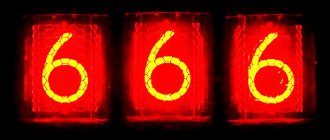This page will always help you find out the date and day of the week for today. At the top of the page there is a calendar for the current month, today is marked in green. Pre-holiday days are marked in orange—working hours have been reduced by one hour. In red - weekends and holidays in the Russian Federation.
Every day has its own specific place and name in the human system. The day of the week, month and year are a precise reference point in the system of time coordinates, thanks to which people plan their daily activities. To track time, man invented not only a clock, but also a calendar - a tool that counts days and years. The calendar allows you to represent time in the form of a ruler, and every student knows how to determine any date. However, this was not always the case.
Key Notes
The Julian Day Number, or more simply put, the Julian Day (JD) is a natural number (including a fractional part) expressing the number of days that have passed since the beginning of 4712. Traditionally, the Julian Day begins at noon Greenwich Mean Time, that it is 12 o'clock Universal Time, UT
).
If the Julian Day refers to a point in time measured on the Dynamic Time scale (or Ephemeris Time), then, as a rule, the term Julian Ephemeris Day, JDE ( eng. Julian Ephemeris Day
) is used.
Example:
26.4 April 1977 UT = JD 2443 259.9 26.4 April 1977 TD = JDE 2443 259.9
The methods described below should take into account the reform of the Gregorian calendar. Namely, the day October 4, 1582 (Julian calendar) is followed by October 15, 1582 (Gregorian calendar). The Gregorian calendar was not immediately recognized throughout the world. This must be taken into account when referring to historical realities. For example, in Great Britain the reform occurred at the end of 1752 AD, and in Turkey the Julian calendar existed until 1927. The Julian calendar was established in the Roman Empire by Julius Caesar in -45, and reached its final form around 8 of the year. However, we will follow the astronomical practice of extrapolating the Julian calendar into the past indefinitely. In this regard, we can talk, for example, about a solar eclipse on August 28 -1203 according to the Julian calendar, although at this distant time the Roman Empire did not yet exist and Emperor Augustus, whose name the month is named, was not even born! This is where astronomers and historians differ in their opinions on how to calculate the years preceding Year 1. We will be years "BC" calculate as is customary in astronomy. That is, the year preceding year +1 is year zero, and the year preceding the last year is year -1. The year that historians call 585 BC corresponds to -584 in astronomy. This negative numbering of years is ideal for mathematical calculations. For example, when historically numbering years, the rule of division by 4 reveals an error: leap years are not a multiple of four: 1st, 5th, 9th, 13th, .... BC. However, when using the astronomical numbering method, the sequence corresponds to the truth: 0th, -4th, -8th, -12th, ... years. are divisible by 4 and are leap days. The rule of division by 4 is not violated. We will denote the integer part of the number x
as INT(
x
), i.e. the number that precedes its fractional part.
Examples:
INT(7/4) = 1 INT(5.02) = 5 INT(8/4) = 2 INT(5.9999) = 5
This can cause some problems with negative numbers. There are two understandings of the INT operation. In some computers and programming languages, INT( x
) is the largest integer less than or equal to
x
.
In this case we will get, for example, INT(-7.83)=-8, since -7 is really greater than -7.83. In other languages, INT is the integer part of the number being written, i.e. the number that precedes the decimal point symbol. Then INT(-7.83)=-7. This operation is called truncation ,
and many programming languages have both functions: INT(
x
), which performs the operation in the first sense, and TRUNC(
x
). From now on, be careful when using the INT function for negative numbers (for positive numbers, both interpretations of the function will give the same result). In the formulas below, the argument to the INT function is always positive.
New Western European calendar
Imagine a situation where, in international negotiations, the calendar of one side is far behind the calendar of the other. Signing international documents in such conditions is impossible, and there cannot be a double date on the papers. In order to avoid difficult situations in the future, the Bolsheviks accepted the time that Europe was enjoying. The Gregorian calendar is Western European. On January 24, Lenin signed the Decree.
Religiously minded citizens were convinced that the adoption of the Gregorian calendar was a purely ideological initiative. Thus, the Bolsheviks wanted to leave the “obscurantist-Black Hundred” calendar in the past. The main goal of the Decree was consolidation with Europe, but the transition had a hard impact on the Russian Church.
Julian Day Calculation
The following method is valid for both positive and negative years, but not for negative Julian Day (JD).
Let for a given calendar date Y
is the year number,
M
is the month number (1 for January, 2 for February, etc., 12 for December), and
D
is the day of the month (with decimal if applicable).
- If M
> 2, then we leave
Y
and
M
unchanged.
If M
= 1 or 2, replace
Y
with
Y
- 1, and
M
with
M
+ 12. In other words, if the original date is in the month January or February, then they are deliberately treated as the 13th and 14th months of the previous year. - If the calculation is carried out according to the Gregorian calendar, then we calculate:
A = INT(Y / 100) B = 2 - A + INT(A / 4)
If the calculation is carried out according to the Julian calendar, we assume
B
= 0. - The desired meaning of the Julian Day is:
JD = INT(365.25(Y + 4716)) + INT(30.6001(M + 1)) + D + B - 1524.5 [1]
The number 30.6 (instead of 30.6001) will give the correct result, but 30.6001 is used to ensure that the integer (the second term in the formula) is found correctly. In fact, instead of 30.6001, you can use both 30.601 and 30.61. For example, the product 5*30.6 gives the integer 153. However, most computers will not represent 30.6 accurately enough, and we might get 152.999998, which, after cutting off the fractional part, will give 152. The calculated JD value will be incorrect.
Example 1
Calculation of the Julian Day for the date 4.81 October 1957, the time of the launch of the first artificial Earth satellite.
We have:
Y
= 1957,
M
= 10,
D
= 4.81.
Since M
> 2, we leave
Y
and
M
unchanged. The date is given according to the Gregorian calendar, therefore:
A = INT(1957 / 100) = INT(19.57) = 19
B = 2 - 19 + INT(19 / 4) = 2 - 19 + 4 = -13
JD = INT(365.25 * 6673) + INT(30.6001 * 11) + 4.81 - 13 - 1524.5
JD = 2436116.31
Example 2
Calculation of the Julian Day for the date January 27, 333, 12h
Since M
= 1, we have:
Y
= 333 - 1 = 332 and
M
= 1 + 12 = 13. Since the date is given according to the Julian calendar, we take
B
= 0.
JD = INT(365.25 * 5048) + INT(30.6001 * 14) + 27.5 + 0 - 13 - 1524.5
JD = 1842713.0
Below is a list of dates with corresponding Julian Day values. This data can be useful when testing programs.
| 1987 Jan 27.0 | 2446822.0 |
| 1987 Jun 19.5 | 2446966.0 |
| 1988 Jan 27.0 | 2447187.5 |
| 1988 Jun 19.5 | 2447332.0 |
| 1900 Jan 1.0 | 2415020.5 |
| 1600 Jan 1.0 | 2305447.5 |
| 1600 Dec 31.0 | 2305812.5 |
| 837 Apr 10.3 | 2026871.8 |
| -1000 Jul 12.5 | 1356001.0 |
| -1000 Feb 29.0 | 1355866.5 |
| -1001 Aug 17.9 | 1355671.4 |
| -4712 Jan 1.5 | 0.0 |
If the date lies between March 1, 1900 and February 28, 2100, in the formula [] we have B
= -13. In some practical problems it is necessary to know the Julian day JD0 corresponding to January 0.0 of a given year (December 31.0 of the previous year). For a year in the Gregorian calendar, JD0 is calculated as follows:
Y = year - 1
A = INT(Y / 100)
JD0 = INT(365.25 * Y) - A + INT(A / 4) + 1721424.5
For years ranging from 1901 to 2099 inclusive, the formula reduces to:
JD0 = 1721409.5 + INT(365.25 * (year - 1))
When is a leap year?
In the Julian calendar,
a year is a leap year (has 366 days) if its numerical value is a multiple of 4. All other years are considered ordinary (365 days).
For example, the years 900 and 1236 were leap years, while the years 750 and 1429 were common years. The same rules apply to the Gregorian calendar
, with the following exception: years ending in two zeros and not divisible by 4, such as 1700, 1800, 1900 and 2100, are common. Other years ending in two zeros and divisible by 400 are leap years: like 1600, 2000, 2400, etc.
In modern practice, the term Modified Julian Day
, MJD (
English: Modified Julian Day
), for example, when indicating the orbital elements of artificial satellites. In contrast to the Julian Day, the Modified Julian Day begins at midnight Greenwich Mean Time. Thus:
MJD = JD - 2400000.5
And, as a result, the day MJD = 0.0 corresponds to the date 0h November 17, 1858.
Syntax
XMPP(Jabber): jd <expression> [!]
WEB request: <expression> [!]
where the expression can be of the following form
Gregorian calendar date in the formats DD-MM-YY-HR-MIN-SEC or DD:MM:YY:HR:MIN:SEC or DD/MM/YY/HR/MIN/SEC
or if we need an inverse task to determine the date of the Gregorian calendar using the Julian date, then we write a pro-Isol number, or a fractional one, and add the service symbol !, which indicates that we need to carry out the inverse transformation.
Day of the week
The day of the week corresponding to a given date can be calculated as follows. You need to calculate JD for this date at 0 o'clock, add 1.5, then divide the result by 7. The remainder of the division will correspond to the day of the week, namely: 0 - Sunday, 1 - Monday, 2 - Tuesday, 3 - Wednesday, 4 - Thursday, 5 - Friday, 6 - Saturday. The sequence of the days of the week was not disrupted by the reform of the Gregorian calendar. So, in 1582, October 4th (Thursday) was followed by October 15th (Friday).
Example 5
Find the day of the week for the date June 30, 1954.
1954 June 30.0 corresponds to the Julian day JD = 2434923.5 2434923.5 + 1.5 = 2434925 The remainder when dividing 2434925 by 7 is 3. Hence the day of the week is Wednesday.
Calendar reform: wasted time
In 1918 there was the longest night: from January 31 to February 13. The country switched to the Gregorian calendar. The Bolsheviks also considered another reformation project. It was supposed to reduce each year by 24 hours, then after 13 years the dates in Russia would completely coincide with the Gregorian calendar. However, Vladimir Lenin approved precisely the abrupt transition. And 13 days simply disappeared from 1918.
The new chronology was introduced into the RSFSR for a reason. The Bolsheviks pursued practical and understandable goals.
Day of the year
Serial number of the day in the year N
can be calculated using the following formula.
N = INT((275 * M) / 9) - K * INT ((M + 9) / 12) + D - 30
where M
– month number,
D
– day of the month, and:
K = 1 for leap year K = 2 for regular year
N
accepts integer values from 1 for January 1 to 365 (or 366 for leap years) for December 31.
Example 6
Find the day of the year for the date November 14, 1978
Ordinary year, M = 11, D = 14, K = 2 We get N
= 318.
Calendar of the ancestors of the Slavs
Wikipedia states that the origin of the word “calendar” has Latin roots. "Kalendae" is the first day of the month. Previously, debt payments were due on Kalends. Therefore, as they explain to us, “accounting books” gradually became a calendar in the modern sense.
Another opinion is that the origin of the word is from “Kalada Dar” and it then spread throughout the world and “reached” Ancient Rome. The following conclusions support this opinion: in Latin “debt” is “debitum”. Do you recognize the familiar “debit”? The Latin word for the book is libra or libellus. Note – “note”, “album” or “literae”. The ancient Romans also had a separate word to denote the concept of loan - “faeneror”. Why then did the notes about the debt, which was recorded and required to be repaid, begin to be called precisely by the first day of the month - “calends”? It turns out that “calendarium” and loans are a rather illogical explanation for the origin of the word “calendar” in its subsequent understanding.
Read about what was predicted for us in 2022 along with clairvoyants and astrologers in the article “Predictions for 2022 for Russia...”
It's time to take stock of the year...
It seems more logical to originate from the gift of Kalyada. Let's consider this statement. Kruglolet Chislobog - another name for the Kalada of the Gift, is based on the 9 and 16 number counting system. Also for the Slavs, the sacred number is 3.
Remember Russian folk tales: the three-headed snake; stone near three roads; distant lands; Far Far Away kingdom; forty forty.
Over the tens of thousands of years of Kalyada, Dar “did not run” ahead and “did not lag behind” even a day! The reason for the accuracy of the Circlet is that it is based on the mathematical model of the Universe. It takes into account the galactic location of the Earth and its axial centralization.
The calendar is displayed by Runes. Sorokovniki is a month of forty days. Fortieth - the first was designated by one Rune, and subsequent ones - by a combination of the Rune of the first Fortieth with the second Rune, which designated part of the rotation of the Earth around Yarila (Sun).
One cycle of the Earth's rotation around Yarila was Summer. If we multiply 40 (days) by 9 (months), we get 360 days. The week consisted of nine days - 9 days.
360 degrees in a circle - maybe this is where they originate? And 360 seconds in an hour?
“Summer” has many concepts in Russian. “How old are you?”, not “years”. And also: chronicle, chronology, in years (middle-aged), in youth, sink into oblivion...
“Let” means to fly without support, and “o” means a circle, “summer” means to fly in a circle.
Dates in the Chronicles were written in letters, not numbers, as Peter the Great ordered.
So, here is how the years were calculated (at the time of the introduction of the calendar from the Nativity of Christ, i.e. 1700):
Summer 7208 from the Creation of the World in the Star Temple;
12708 from the Great Cold;
44244 from the Creation of the Great Colo of Russia;
106478 from the Founding of Asgard of Iria;
111813 from the Great Migration from Daariya;
And further, until Summer 604,074 from the Time of Three Suns...
Let us remember that this is as of 1700, i.e. We add to these dates the 320 years that have passed since Peter’s reform.
In March 2022, the 7528th summer begins from the Creation of the World in the Star Temple.
What is Hijra
In Islam, this concept has a multi-level meaning that is difficult to understand. But in historical terms, hijra is the transition of the Prophet Muhammad from Mecca, where he was born and raised, to Medina. Essentially, it symbolizes the transition from evil to good.
It was this event that was accepted as the beginning of the Muslim lunar calendar. This happened after the death of the Prophet Muhammad himself during the reign of Caliph Omar. Naturally, the Muslim calendar by months does not coincide at all with the Gregorian calendar generally accepted in the Christian world. And the notorious “New Year” according to the Muslim calendar does not overlap with the traditional Western one.
Months of the Muslim calendar
| Title (Russian) | Title (Arabic) | Meaning |
| Muharram | محرّم | A sacred and forbidden month during which military campaigns and battles are prohibited. |
| Safar | صفر | It comes from the word from “safar” - yellow, as the leaves begin to turn yellow in this month. |
| Rabi al-awwal | رَبيع الأوّل | “The first month of spring” (from the word “rabi” - spring). |
| Rabi as-sani | ربيع الثاني | "Second Spring". The variant Rabiu al-akhir - “last spring” is also used. |
| Jumada al-Ula | جُمادى الأولى | "Cold month" From the word “jumada” - to freeze, to freeze. The name Jumada al-awwal is also used. |
| Jumada al-sani | جمادى الثاني | The word "jumada" is used to refer to dry lands. The name Jumada al-akhir is also used. |
| Rajab | رَجَب | "Abstain from violence." During this month, along with Muharram, military operations and campaigns are prohibited. |
| Shaban | شَعْبان | From the word “tashaba” - to spread, to divide. The month in which the Arabs went on campaigns and battles in different directions. |
| Ramadan | رَمَضان | From the word “Ar-ramda” - hot, scorching, sultry. The holy month of Muslims, the month of the revelation of the Koran and fasting. |
| Shawwal | شَوّال | From the word “Tashavvala” - the need for camel milk. A month of nomadism. |
| Zu-l-qada | ذو القَعْدة | "Month of Settlement" A sacred month during which nomadism and military operations ceased. |
| Dhu'l-Hijjah | ذو الحِجّة | Month of pilgrimage to Mecca. |










